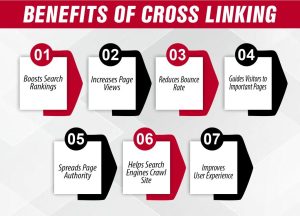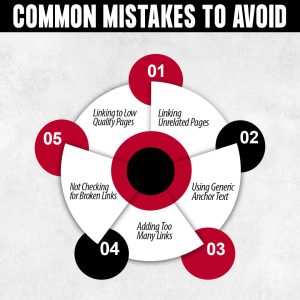Did you know that websites with smart cross linking can rank higher on Google and get more visitors?
Many website owners still don’t know what cross linking is in SEO or how to use it right. Without it, they miss chances to boost traffic and keep visitors engaged.
At Phoenix Dial, we believe in clear connections — just like our doctors guide patients step by step, we help businesses understand smart SEO links that work like a healthy network.
This post will show you what is cross linking in SEO means, why it matters, and simple ways to do it well. Keep reading to build a stronger website!
Table of Contents
ToggleStart Growing Your Business Today
Get a free, personalized quote via WhatsApp for your business. No pressure—just smart solutions tailored to your goals.
What is Cross Linking?
Let’s define cross linking in simple words. Cross linking means connecting one page on your website to another page on the same site. It helps people move easily from one page to the next. Many people ask, what is crosslink? It’s just a smart way to guide visitors and search engines through your site.
Difference from backlinks/internal links
Cross linking is often mixed up with backlinks and internal links. Here’s the difference:
- Backlinks come from other websites to your website. For example, another site links to your blog — that’s a backlink.
- Internal links and cross links are very similar. Both connect pages within your site. But when you plan links to connect related pages, that’s cross linking. Think of it as a planned link in SEO that boosts ranking and helps visitors.
E.g
Imagine you have a blog post about “Healthy Diet Tips” and another page about “Low Sugar Recipes.” By cross linking, you add a link from the diet post to the recipes page. This way, readers find more helpful info, and your linking SEO works better. If you ever wonder who is linking to my website, you can check backlinks, but cross linking is fully in your hands. Use it to make your pages strong and easy to find!

Benefits of Cross Linking
Cross linking comes with many rewards for your website. It can make your pages stronger, more trusted, and more interesting for visitors. Keep reading to see how each benefit works!
Boosts Search Rankings
One big benefit of cross linking is higher search rankings. When you link related pages, search engines see that your content is connected and useful. This makes your site more trustworthy. If you wonder what is crosslink or what is cross linking in SEO, remember it’s a way to build strong page networks. For example, linking a blog post to a product page shows Google that both pages matter. Over time, this helps your pages rank better for your target keywords and improves your linking SEO plan.
Increases Page Views
Cross linking also helps people visit more pages on your site. When readers see helpful links in your articles, they click and keep reading. This means they spend more time exploring your content. For example, someone reading about skincare might click a link to see your best skin products. This simple act boosts page views and keeps visitors happy. It’s a smart part of linking in SEO that makes your site stronger and your audience more engaged.
Reduces Bounce Rate
Cross linking helps lower your bounce rate. Bounce rate means visitors leave your site after viewing only one page. When you add helpful links inside your content, people find more to read and stay longer. For example, a reader on a blog about fitness tips may click a link to a page about meal plans. This keeps them engaged and shows search engines that your site is useful. Good linking in SEO always aims to reduce bounce rate.
Guides Visitors to Important Pages
Cross linking also guides people to pages you want them to see. For example, in a blog post, you can link words like “Contact Us” or “Our Services.” This pushes visitors to key pages without forcing them to search. It’s a simple way to answer the question who is linking to my website — you’re doing it inside your own site! Smart linking like this builds trust and helps visitors take action.
Spreads Page Authority
When you define cross linking, it’s good to know that it shares strength between pages. A strong page can pass some of its power to a weaker page by linking to it. For example, if your homepage ranks well, linking it to a new blog helps that blog gain value too. This smart link sharing makes your whole site stronger in the eyes of search engines. It’s a key part of good linking SEO and supports your growth naturally.
Helps Search Engines Crawl Site
Cross linking makes it simple for search engines to find every page on your site. When pages are linked together, search bots move easily from one page to the next. If you ever wondered what is cross linking in SEO, think of it as giving search engines a clear path to follow. This means no page gets hidden or left out. A good network of links helps your whole site show up in search results and supports better SEO sitelinks over time.
Improves User Experience
Smart cross linking also makes your website easy and fun to use. When pages connect well, visitors don’t get lost. They find answers fast and discover more helpful content. For example, a blog about dental care can link to an appointment page or an FAQ. This keeps readers happy and builds trust. Good links guide people step by step — just like good care guides patients. Using clear links is a simple way to collaborate SEO and keep your visitors coming back.
Best Practices for Cross Linking
Cross linking works best when you follow some simple rules. These best practices help your links stay helpful for visitors and trusted by search engines. Let’s look at what to do:
Link Relevant Pages Only
Always link pages that match the topic. For example, link a blog about healthy meals to a page about nutrition tips, not to something unrelated like car repair. When links match, search engines see that your site covers the topic well. This is key when you want to define cross linking in a way that helps your linking SEO stay strong.
Use Clear Anchor Text
Anchor text is the word or phrase people click on. Make sure it clearly says what the linked page is about. For example, use “view our dental services” instead of “click here.” Good anchor text helps visitors and tells search engines what to expect. This simple step makes your link in SEO plan clearer and more trusted.
Limit Number of Links
Too many links on a page can confuse people and look spammy. Use a few strong links that truly help readers. For example, 2–5 good links in a blog post are enough. Quality is better than quantity. Following this keeps your cross linking definition clean and supports better site flow for both users and search engines.
Update Old Content with New Links
When you write new pages or posts, go back and add links to your older content. This keeps old pages fresh and connected to your latest ideas. For example, link a new article about tooth care to an older one about brushing tips. This simple linking in SEO step helps search engines and readers find your best work, old and new.
Check Links Regularly
Broken links can hurt your SEO and confuse visitors. Take time to check your links often. Make sure they work and lead to the right pages. Fix or update any link that is broken. This shows search engines that your site is healthy and cared for. Good linking SEO always includes regular link checkups.
Place Links Naturally in Content
Add links where they fit naturally. Don’t stuff a link just to have it. If you explain a topic and have another page with more details, that’s a good spot for a link. This makes your writing flow well and keeps readers happy. A clean cross linking definition always includes links that feel natural, not forced.
Link Deep, Not Just to Homepage
Don’t only link back to your homepage. Guide visitors to deeper pages, like detailed articles or product pages. For example, link to a service page or a special blog post instead of sending everyone to the main page. Deep links spread value across your whole site and help answer who is linking to my website with stronger page connections. This builds a healthy, trusted website structure.

Common Mistakes to Avoid
Cross linking helps your site only if you do it right. Many people make small mistakes that can hurt SEO instead of helping it. Here are some common errors to watch out for:
Linking Unrelated Pages
Never link pages that have nothing in common. For example, linking a blog about eye care to a page about cooking tips makes no sense. This confuses visitors and search engines. It weakens your linking SEO plan and breaks trust. Always link related topics so your content stays clear and helpful.
Using Generic Anchor Text
Avoid boring words like “click here” or “read more.” These don’t tell visitors or search engines what the link is about. Instead, use clear words that match the page you link to. For example, say “learn about teeth cleaning” instead of “click here.” This makes your link in SEO stronger and user-friendly.
Adding Too Many Links
Putting too many links in one page can look spammy. Visitors may feel lost or overwhelmed. Search engines may see it as low quality. Focus on adding a few good links that truly help the reader. This keeps your site clean and your cross linking definition solid and trusted.
Not Checking for Broken Links
One common mistake is ignoring broken links. If a link does not work, visitors see an error page and may leave your site. This hurts trust and can lower your rankings. Always check your links often. Fix or remove broken ones quickly. A healthy site with working links shows you care about good linking SEO and user experience.
Linking to Low-Quality Pages
Avoid linking to pages that have weak or poor content. Low-quality pages add no value and can hurt your site’s trust. For example, don’t link to short pages with little information or spammy content. When you collaborate SEO through cross linking, make sure every page you link is useful, clear, and adds real help for your visitors.
Conclusion
Cross linking is a simple but powerful way to make your website stronger. It helps search engines find your pages, keeps visitors on your site longer, and guides them to the right information. When done well, cross linking supports better rankings and a smooth user experience.
Remember to link only related pages, use clear words for your links, and check them often. Avoid common mistakes like broken or spammy links. By following these easy steps, you build trust with search engines and keep your visitors happy.
Start using smart cross linking today — it’s one of the easiest ways to boost your SEO and grow your site naturally!
FAQ’s
How does cross linking help my website?
Cross linking builds strong connections between pages. It boosts search rankings, keeps people on your site longer, and guides them to important information or services.
Is cross linking the same as backlinks?
No. Backlinks are links from other websites to your site. Cross linking happens inside your own site, connecting your pages to each other.
How many cross links should I add to a page?
Use a few helpful links—usually 2 to 5 per page. Focus on quality, not quantity. Make sure they match the topic and help the reader.
How do I find which pages to link?
Look for pages with related topics. For example, link a blog post about eye health to your “Eye Care Services” page.
What happens if I don’t check my links?
Broken links can hurt your SEO and frustrate visitors. It’s good practice to check your site for broken links every few months and fix them fast.
Can cross linking hurt my SEO?
Cross linking only hurts if you overdo it, link unrelated pages, or use spammy links. When done right, it is safe and helpful for your SEO.




